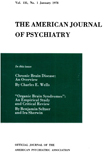THE ADVANTAGES OF NITROUS OXIDE INHALATION IN PSYCHIATRIC TREATMENT
Abstract
1. Previously described methods of inhalation anæsthesia and hypoxia in psychiatric conditions have been reviewed.
2. A technique of nitrous oxide administration beyond the state of intoxication and avoiding the Stage of deep hypoxemia has been described.
3. Physiological changes with this form of anæsthesia are slight and the method may be considered safe.
4. After the anæsthesia, a period of facilitation of mental processes is observed, which is followed by a period of relaxation and sedation.
5. During the phase of facilitation, the patient has a feeling of increased well-being and shows greater spontaneity, less resistance, and enhanced insight, often expressing previously repressed ideational content and affects.
6. The period of sedation lasts for several hours and is not associated with drowsiness or confusion. Sleep is usually improved the following night and other sedation is often unnecessary.
7. In states of acute manic excitement, repeated daily administration of nitrous oxide has controlled and terminated the attack in some cases.
8. Nitrous oxide hypoxia produces some of the features of the "shock treatments" as well as of narcoanalysis, but it is safe, convenient, and simple in administration and may be used in ambulatory patients without interruption of their ordinary activities.
9. The theories on the pharmacological action of nitrous oxide and the reason for its choice are discussed.
Access content
To read the fulltext, please use one of the options below to sign in or purchase access.- Personal login
- Institutional Login
- Sign in via OpenAthens
- Register for access
-
Please login/register if you wish to pair your device and check access availability.
Not a subscriber?
PsychiatryOnline subscription options offer access to the DSM-5 library, books, journals, CME, and patient resources. This all-in-one virtual library provides psychiatrists and mental health professionals with key resources for diagnosis, treatment, research, and professional development.
Need more help? PsychiatryOnline Customer Service may be reached by emailing [email protected] or by calling 800-368-5777 (in the U.S.) or 703-907-7322 (outside the U.S.).



